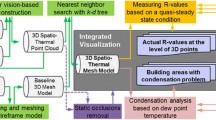Abstract
In recent years 3D models of buildings are used in maintenance and inspection, preservation, and other building related applications. However, the usage of these models is limited because most models are pure representations with no or little associated semantics. In this paper we present a pipeline of techniques used for interior interpretation, object detection, and adding energy related semantics to windows of a 3D thermal model. A sequence of algorithms is presented for building the fundamental semantics of a 3D model. Among other things, these algorithms enable the system to differentiate between objects in a room and objects that are part of the room, e.g. floor, windows. Subsequently, the thermal information is used to construct a stochastic mathematical model– namely Markov Random Field– of the temperature distribution of the detected windows. As a result, the MAP(Maximum a posteriori) framework is used to further label the windows as either open, closed or damaged based upon their temperature distribution. The experimental results showed the robustness of the techniques. Furthermore, a strategy to optimize the free parameters is described, in cases where there is a sample training dataset.
Similar content being viewed by others
References
Adan, A., Huber, D.: 3d reconstruction of interior wall surfaces under occlusion and clutter. In: International Conference on 3D Imaging, Modeling, Processing, Visualization and Transmission (3DIMPVT). IEEE, pp. 275–281 (2011)
Besag, J.: Statistical analysis of non-lattice data. The statistician 24, 179–195 (1975)
Besag, J.E., Moran, P.A.: On the estimation and testing of spatial interaction in gaussian lattice processes. Biometrika 62(3), 555–562 (1975)
Besl, P., McKay, N.: A method for Registration of 3–D Shapes. IEEE Trans. Pattern Anal Mach Intell 14(2), 239–256 (1992)
Bishop, C.M.: Pattern recognition and machine learning, vol. 1. Springer, New York (2006)
Borrmann, D., Elseberg, J., Lingemann, K., Nüchter, A., Hertzberg, J.: Globally consistent 3d mapping with scan matching. J. Robot. Auton. Syst. (JRAS) 56(2), 130–142 (2008)
Borrmann, D., Afzal, H., Elseberg, J., Nüchter, A.: Mutual Calibration for 3D Thermal Mapping. In: Proceedings of the 10th International IFAC Symposium on Robot Control (SYROCO ’12), vol. 10, Dubrovnik (2012)
Bradski, G., Kaehler, A.: Learning OpenCV, computer vision with OpenCV library, 1st edn. O’Reilly Media (2008)
Clifford, P.: Markov random fields in statistics. Disorder in Physical Systems, pp. 19–32 (1990)
Elseberg, J., Borrmann, D., Nüchter, A.: Full Wave Analysis in 3D Laser Scans for Vegetation Detection in Urban Environments. In: Proceedings of the XXIII International Symposium on Information, Communication and Automation Technologies (ICAT ’11). IEEE Xplore, Sarajevo (2011)
Elseberg, J., Borrmann, D., Nüchter, A.: One billion points in the cloud–an octree for efficient processing of 3D laser scans. ISPRS Journal of Photogrammetry & Remote Sensing (JPRS), Special issue on terrestrial 3D modelling, vol. 76, pp. 76–88. Elsevier Science (2013)
Fischler., M., Bolles, R.: Random sample consensus: a paradigm for model fitting with applications to image analysis and automated cartography. Commun. ACM 24(6), 381–395 (1981)
FLIR Systems AB: Thermal imaging guidebook for building and renewable energy applications. In cooperation with the Infrared Training Center (ITC), Sweden (2011)
Fouad, N.A., Richter, T.: Leitfaden thermografie im bauwesen – theorie, anwendungsgebiete, praktische umsetzung, 4th edn. Fraunhofer IRB Verlag, Stuttgart (2012)
Ham, Y., Golparvar-Fard, M.: An automated vision-based method for rapid 3d energy performance modeling of existing buildings using thermal and digital imagery. Adv. Eng. Inform. 63, 15–28 (2013a)
Ham, Y., Golparvar-Fard, M.: EPAR: Energy Performance Augmented Reality Models for Identification of Building Energy Performance Deviations between Actual Measurements and Simulation Results. Energy and Buildings (2013b)
Holz, D., Holzer, S., Rusu, R.B., Behnke, S.: Real-time plane segmentation using rgb-d cameras. In: Proceedings of the 15th RoboCup International Symposium, Istanbul (2011)
Hornung, A., Wurm, K.M., Bennewitz, M., Stachniss, C., Burgard, W.: OctoMap: An efficient probabilistic 3D mapping framework based on octrees. Auton. Robot. (2013). doi:10.1007/s10514-012-9321-0. Software available at http://octomap.github.com
Jordan, A.: On discriminative vs. generative classifiers: A comparison of logistic regression and naive bayes. Adv. in Neural Inf. Process. Syst. 14, 841 (2002)
Laguela, S., Daz-Vilarino, L., Arias, J.A.P.: Non-destructive approach for the generation and thermal characterization of an as-built bim. Constr. Build. Mater. 51, 55–61 (2014)
Luhmann, T., Piechel, J., Ohm, J., Roelfs, T.: Geometric calibration of thermographic cameras. In: International Archives of Photogrammetry, Remote Sensing and Spatial Information. Commission V Symposium, vol. 38 part 5, Newcastle upon Tyne (2010)
Madras, N.: Lectures on monte carlo methods. Fields Institute for Research in Mathematical Sciences Toronto: Fields Institute Monographs, American Mathematical Society (2002)
Pangercic, D., Tenorth, M., Pitzer, B., Beetz, M.: Semantic object maps for robotic housework - representation, acquisition and use. In: Proceedings of the IEEE/RSJ International Conference on Intelligent Robots and Systems (IROS ’12), Vilamoura (2012)
Pedersen, C., Hellevang, K.: Insulation and air infiltration levels. Circ. AE (NDSU Ext. Serv.) 1373 (2008)
Schnabel, R., Wessel, R., Wahl, R., Klein, R.: Shape recognition in 3d point-clouds. In: The 16-th international Conference in Central Europe on Computer Graphics, Visualization and Computer Vision (2008)
Surmann, H., Nüchter, A., Hertzberg, J.: An autonomous mobile robot with a 3D laser range finder for 3D exploration and digitalization of indoor environments. J. Robot. Auton. Syst.(JRAS) 45(3–4), 181–198 (2003)
Vosselman, G., Mass, H.G. (eds.): HGM Airborne and Terrestrial Laser Scanning. Whittles Publishing, Scotland (2010)
Xiong, X., Huber, D.: Using context to create semantic 3d models of indoor environments. In: British Machine Vision Conference, Aberystwyth, pp. 45–1 (2010)
Author information
Authors and Affiliations
Corresponding author
Rights and permissions
About this article
Cite this article
Demisse, G.G., Borrmann, D. & Nüchter, A. Interpreting Thermal 3D Models of Indoor Environments for Energy Efficiency. J Intell Robot Syst 77, 55–72 (2015). https://doi.org/10.1007/s10846-014-0099-5
Received:
Accepted:
Published:
Issue Date:
DOI: https://doi.org/10.1007/s10846-014-0099-5




